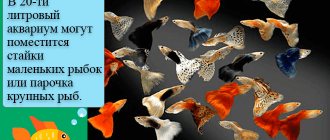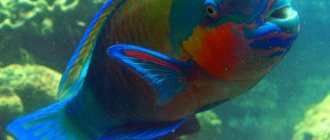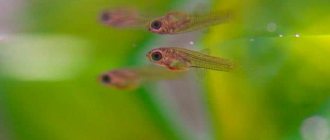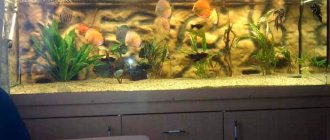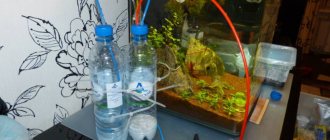Friends, the material below is intended for those who are just getting acquainted with the concept of “marine aquarium” and are beginning to understand what corals are and what types they come from. Don't worry, we've all been in your shoes. Once upon a time, I was confused for a long time by the abbreviations “LPS” and “SPS”, dividing all corals into “beautiful”, “brown” and “I want him to do Viu-Viu!” When a new aquarist starts reading about marine systems, there is a wealth of new information, words and acronyms that are not used in freshwater aquariums. Of course, your head is spinning and you really need to remember the names of the corals. And everything at once! Now I’ll try to explain it as simply as possible in groups
So, there are four main groups of benthic (attached to the bottom/rock/glass) aquatic organisms, which we all call corals: soft corals, semi-hard corals (LPS-corals), hard corals (SPS-corals) and anemones (anemons). ). By the way, the latter have nothing to do with corals, but this does not prevent hobbyists from classifying them in this group. Let's look at each group with examples.
SOFT CORAL (softies)
Traditionally considered the simplest type of coral. Their main advantage is the ability to forgive many of the mistakes of a novice aquarist, and not only survive, but also bloom and smell. The best choice for an aquarist-sailor who is just starting his journey in our interesting business. The main difference between soft coral is that it completely lacks a calcium (hard) skeleton. That is, it is impossible to find a hard rocky area anywhere on the body of the coral (the pebble to which it is attached or which it covers does not count!). Here are a couple of examples of the most common soft corals: - creeping species (umbrellas, palitoi, anthelia, brearium, discosomas, rhodactis, ricordea, etc.) - soft corals “on a stalk” (capnella, sarcophyton, lobophytum, sinularia, cladiella, etc.)
That is, if the coral has nothing hard, it is a soft coral. From practice I will add that if the coral is brown, then most likely it is soft. In general, beginners usually start with soft corals. But they have a huge disadvantage: soft coral is only beautiful if you can control its population. Once you fail to control their growth, they quickly turn from beautiful patches into weeds that cannot be removed. And the worst thing is that the more inconspicuous the soft coral, the faster it grows, squeezing out everyone in its path. If you are sure that you will ALWAYS have only soft corals in your aquarium, plant them directly on the main reef. If you plan to add other types of coral in the future, limit the space for soft types to sand. Soft corals (umbrellas, palitoi, antelia and many others) are not able to grow on sand. Select individual pebbles from the main reef and plant purchased umbrellas and other soft ones there. Then their growth will be controlled and aesthetically beautiful. Separately, I will say a few words about fracking and removing soft corals. Sooner or later they will grow so large that they will begin to interfere with each other, kill their neighbors to clear the territory for further growth, and you will decide to sell or donate individual colonies to someone. How to separate the coral in this case? If we are talking about “tree” type corals, you can simply take it at the base with your hands (with gloves!) and pull it along the stone against the growth, tearing it off entirely. The detached colony can be tied with an elastic band from the shipping bag onto a separate pebble or block. After a week, the coral will grow to the new support and the rubber band can be removed. Mushroom-type corals (lobophytum, sarcophyton, large rhodactis) can simply be cut with scissors, either in half or a small piece. Fragments of fleshy mushrooms (sarcophyton, lobophytum) are also tied with a rubber band to the stone; small ones such as rodactis, ricordei, diskos can be pinned with a pin or several pins to the stone during growth. Soft umbrella-type corals are removed at the root with tweezers, “pulling” them from the stone and then glued onto a separate pebble using water-based superglue (superglue - gel). And the last thing:
It is impossible to remove entire soft corals from the reef! If you have already planted softness, then it will always come back to haunt you. You can pluck it, poison it, turn over stones, clean them, draw pentagrams around the aquarium - all the same, the soft ones will survive from a millimeter of tissue and will grow again. But this is not bad - there are a huge number of beautiful reefs with predominantly soft corals, for example:
Artificial decorations for the aquarium: pros and cons
The use of all kinds of artificial decorative elements provides a number of advantages
:
- no problems with rotting and diseases
- do not require special care
- fish do not confuse them with food
- do not change the chemical composition of water like, for example, living corals or driftwood
- durable
But such decorations also have their drawbacks.
which are also important to consider:
- Products made from low-quality materials may be toxic
- some good quality artificial decorations (corals, shells, plants, etc.) are not cheap
- There are many artificial plants and corals on sale, the unnatural origin of which immediately catches the eye, so they not only will not add charm to your underwater kingdom, but will also leave a feeling of its unnaturalness.
Creation date: 05/04/2017
SEMI-HARD CORAL (LPS)
LPS (Large Polyp Stone corals) is an English acronym that literally means “Large Polyp Stone Corals.” Having remembered the name, it is quite easy to visually determine whether an LPS coral is in front of you or not. All corals that have a hard (calcium) foot and large polyps and/or mouths are by definition LPS corals. Vivid examples: acanthastraea, eufillia, duncan, caulastrea, lobophyllia, etc. There are more complicated options, when the hard calcium skeleton is hidden under the coral mantle and is not visually visible. In addition, LPS corals often include those species that do not have clearly defined large heads. The bottom line is that everything that has a calcium base (solid) and even a little, even just 3 millimeters of tissue with clearly defined mouths - all these are semi-solid types. These include all types of chalis, pectinia, favia and favites, symphyllia, goniastrea, etc. LPS corals grow more slowly than soft corals and are more demanding of both lighting and water quality in the aquarium. They urgently need basic macro and microelements in water. Some species are in dire need of spot feeding directly into the coral's mouths. If you decide to try to grow these species in your aquarium, start with the simplest of them: caulastraea, duncan, hammerhead, acanthastraea, and favites-type brainweed. Almost all of them require mid-flow and full-spectrum lighting is highly desirable.
Among the more complex LPS corals, we can distinguish catalaphyllias, torch euphyllias, trachyphyllias, echinophyllias and other types of chalice, montastrea, platigyra, etc. LPS corals with a stem are very easy to frag: take it out, break it off/bite it off, glue it with two-component glue and you're done. Encrusting corals (those with no visible calcium skeleton) are fraged either by breaking off (if growing in a cup) or by beating/cutting off a piece of tissue and the skeleton together.
Additional decorative elements
Ceramic products in the form of castles, grottoes, caves, etc. – a great opportunity to create an unusual underwater kingdom with a memorable design. You can also use ordinary household items such as saucers, cups, clay pots and vessels as decorations. They can even be used as shelters by installing them upside down and having previously made an “entrance”. But only install new clay products in the aquarium, since this material is very porous, and you will not be able to remove harmful substances from it even with the most thorough cleaning.
SPS CORAL
SPS (Small Polyp Stone coral) - small polyp stony corals, that is, all those that are hard and with a minimal amount of tissue. The classic example of hard corals is all types of Acropora, which novice aquarists often associate with painted sticks in the aquarium. In fact, this is the most demanding class of corals in general. They are not as gentle as many people think and are capable of surviving a lot, but! If you mess up an aquarium with soft corals, they will shrink and sniffle, but they will survive. If you stumble just a little in a reef with hard corals, within 12-24 hours they can all turn into a white dead skeleton without the possibility of recovery. That is, their main difficulty in keeping is consistently good parameters in the aquarium, regardless of force majeure outside the aquarium: heat of 35 degrees; power outages for a day, breakdown of the auto-topping sensor, etc. SPS corals rarely forgive mistakes.
The classic example of hard corals is all types of Acropora, which novice aquarists often associate with painted sticks in the aquarium. In fact, this is the most demanding class of corals in general. They are not as gentle as many people think and are capable of surviving a lot, but! If you mess up an aquarium with soft corals, they will shrink and sniffle, but they will survive. If you stumble just a little in a reef with hard corals, within 12-24 hours they can all turn into a white dead skeleton without the possibility of recovery. That is, their main difficulty in keeping is consistently good parameters in the aquarium, regardless of force majeure outside the aquarium: heat of 35 degrees; power outages for a day, breakdown of the auto-topping sensor, etc. SPS corals rarely forgive mistakes.
You will then say: “Why do I need them at all, if there are so many headaches?” Yes, everyone thinks so at first. But, if you like marine aquarium keeping, sooner or later you will want to test your strength and abilities. And you will first get one very simple hairy spp coral: seriatopora or stylophora or a simple montipora. It will take root and grow. And you will want to complicate your calm and measured aquarium life. You will take more complex species: Acropora valida “starry sky”, Montipora “forest fire”, densely polypous Acropora millipora and away we go…. Almost everyone does this. Is it true. The only thing I want to warn you right away is do not take hard corals if:
- you do not have a full set of tests for biogen (nitrate + phosphate) and macroelements (CN, calcium, magnesium) - you do not have a good lamp (not for the price, but according to a specialist whose opinion you trust) - your temperature is specifically unstable in an aquarium - these are your first corals in life. SPS corals frag by breaking off a branch from the mother bush, and very often this happens by accident (they caught a fish and got hooked with a net; a fat blue surgeon turned around unsuccessfully in an aquarium, etc.). These corals are placed at the very top of the reef under maximum light. The current should be strong, but not direct (the pump blows directly onto the coral), but indirect (from glass, from stone, etc.).
Plants
Living plants, as a rule, are not used when decorating a pseudo-sea. This is due to a number of reasons:
- Large fish and cichlids, which in most cases become residents of a pseudo-marine aquarium, are not compatible with living plants. They can eat them or dig them up, tearing up the soil.
- The natural corals used greatly increase water hardness, which is uncomfortable for plants.
- Finally, many popular plants will look out of place in a pseudo-sea, since they bear little resemblance to real seaweed.
ANEMONES
We wrote separately about anemones and their classification in an article about how to transfer anemones to your aquarium after purchase. In general, anemones are not classified as corals. These are close relatives of jellyfish in the hydrobiont class, but this does not matter to most hobbyists. Many experienced sailors believe that the sea anemone should not be placed first in a fresh aquarium. We are categorically against this opinion and believe that the sea anemone should be one of the first to be planted if it is on your wish list. The problem is that anemones must crawl around the aquarium in search of the perfect place for themselves. They look for the ideal flow, photosynthetic anemones also choose a “place in the sun” and this process can be very long. All soft corals on which the sea anemone crawls will close and eventually open again when it leaves them. All LPS and SPS corals that she walks on will be killed by her gore tentacles.
That is why it is best to plant the anemone first in the aquarium, give it time to gain a foothold in its chosen place and then plant the rest of the corals around it. This does not mean that in six months the sea anemone will not crawl again, but still the risks of losing neighboring corals will be minimized. Please note that sea anemones tend to inflate and deflate. You must calculate the space she will need at maximum body inflation so that she will not be able to reach nearby corals. In addition, when fed with protein meat, sea anemones actively grow, significantly increasing in size. Dividing anemones is a different story. The vast majority of them divide on their own, throwing out “babies” - small identical anemones next to them. Large anemone species can be divided by cutting the anemone directly across the mouth, but we strongly advise against doing this without years of experience dividing corals in this way. Removing a baby sea anemone from a stone (for example, for sale) is quite difficult. Sea anemones tightly hide their leg in a rock crevice and it is not easy to pick it out. The simplest method is to cover the small anemone with a PVC pipe so that it feels like there is “light at the end of the tunnel”. Most sea anemones are photosynthetics and in such a situation they will immediately crawl towards the light to preserve their lives. Thus, the sea anemone will crawl out entirely onto a smooth PVC tube, from which it is very easy to remove. By the way, in the same way they successfully get rid of anemone weeds: aiptasia and mayano. But that is another story.
RESULT
In fact, it is very rare to find marine systems in which only one class of aquatic organisms listed above is present. Mixed reefs look the most beautiful: when there are a few soft umbrellas and mushrooms; and there are fluttering euphyllias and incredibly beautiful chalis; and there are powerful bushes of shaggy seriatopors and acroporous horns peeking out from behind the stone. But at the same time, the more soft corals there are in your reef, the simpler and easier it will be to care for it and keep the aquarium beautiful and fragrant. The more SPS corals there are, the more money you will spend on maintaining the aquarium and the more indignant your significant other will be about the length of time spent caring for the aquarium. For example, here is a video of a mixed aquarium with a predominance of soft corals. Beautiful, isn't it? This aquarium is located in Lutsk in the Decorative Ribka store.
Here is the same mixed reef, but with a predominance of hard corals. This aquarium is located in Boyarka, not far from Kyiv, and the owner of the system is a fan of marine aquariums.
And here is another successful project of a hobbyist from Kyiv, which clearly shows that even 100 liters with a side sump can be made very beautiful:
I would especially like to say something about the coral planting.
If we take it as an axiom that you have a good lamp designed specifically for your aquarium, then the planting scheme should be as follows: - the lower part of the aquarium (minimal lighting + minimal airflow): soft and LPS corals that do not require strong lighting - the middle layer of the aquarium (medium light): LPS corals and low-demanding SPS corals (e.g. seriatopora, stylopora, stylophora, montipora) - top of the aquarium (maximum light): all SPS corals and LPS corals with a wide range of lighting requirements (Duncan, Euphyllia etc.)
In any case, it's up to you to decide. And we, as always, will help and advise
And we, as always, will help and advise
Pseudo-sea design - imitation of the seabed
Almost everyone who has ever admired a marine aquarium would like to have one in their own home. It’s rare to see such an abundance of bright colors and unusual life forms of animals. However, maintaining balance in a saltwater aquarium requires some experience, and the equipment and inhabitants are quite expensive. If you are not yet ready to maintain a real “sea”, but really want to have something similar at home, then you can decorate your aquarium in the style of a pseudo-sea. And we will tell you how to do this in our article.




